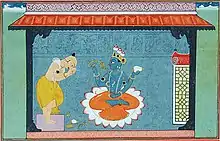Narayana sukta
The Narayana Sukta or Narayana Suktam (Sanskrit: नारायणसूक्तम्, romanized: Nārāyaṇasūktam) is a Hindu hymn propitiating Narayana (Vishnu), featured in the 13th anuvaka (section) of the 10th prapathaka (chapter) of Taittiriya Aranyaka, which is part of the Krishna Yajurveda generally dated between c. 1200–1000 BCE.[2] In this hymn, Vishnu is extolled as the Supreme Being.[3]
"Whatever all this universe is,
seen or heard of—pervading all this,
from inside and outside alike,
stands supreme the Eternal Divine Being (Narayana).[1]
| Part of a series on |
| Vaishnavism |
|---|
 |
| Part of a series on |
| Hinduism |
|---|
 |
It is venerated as one among the five hymns from the Vedas called the Pancha Sukta by Vaishnavites, the other four usually being the Purusha Sukta, the Sri Sukta, the Bhu Sukta, and the Nila Sukta. Some commentators see it as a mystical appendix to the Purusha Sukta.[4]
Description
The first verse of Narayana sukta mentions the words "Paramam Padham" Which literally means "highest position" which is commonly understood as the "Supreme abode for all the souls".[5] Such high status is not given to any other god other than Vishnu.[6] In this hymn, Narayana is described to be the one with a thousand heads, the one who watches and illuminates all.[7] The deity is stated to pervade all of existence, be indestructible and eternal, the heart of all things, and the one who does good to all. He is also stated to be the Absolute, and the supreme meditation. A simile of the hymn compares the heart to an inverted lotus bud, equidistant between the collarbone and the navel. At the centre of this heart, a great fire with flames that radiate all sides is said to burn. This fire is described to assimiliate food and distribute this energy from the head to the foot of the body. Another simile compares the flame to a flash of lightning in a blue-black cloud and a sprout of barley husk, one that is as tiny as an atom and ever conscious. At the centre of this flame, the Supreme Being is described to reside, called Brahma, Vishnu, Shiva, as well as Indra, that which is transcendant and existence itself.[8]
See also
References
- Translation from Verse 5 of the Narayana sukta.
- Witzel 2001, pp. 5–6.
- Chugh, Lalit (23 May 2017). Karnataka's Rich Heritage – Temple Sculptures & Dancing Apsaras: An Amalgam of Hindu Mythology, Natyasastra and Silpasastra. Notion Press. p. 94. ISBN 978-1-947137-36-3.
- David Frawley (16 September 2010). Mantra Yoga and Primal Sound: Secret of Seed (Bija) Mantras. Lotus Press. pp. 158–. ISBN 978-0-910261-94-4. Retrieved 21 July 2012.
- https://www.google.co.in/books/edition/Karnataka_s_Rich_Heritage_Temple_Sculptu/fdEkDwAAQBAJ?hl=en&gbpv=1&dq=Narayana+suktam&pg=PT94&printsec=frontcover
- https://www.google.co.in/books/edition/Karnataka_s_Rich_Heritage_Temple_Sculptu/fdEkDwAAQBAJ?hl=en&gbpv=1&dq=Narayana+suktam&pg=PT94&printsec=frontcover
- Ravi, V. Vishnu Sahasranama. MANBLUNDER. p. 364.
- Ritajananda, Swami (15 July 2022). The Practice Of Meditation. Sri Ramakrishna Math. p. 89.